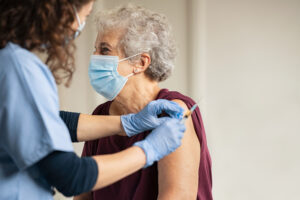COVID-19: Where We Were, Are, and Expect to Be
One year ago this month, the TAG team came together (in person!) from across the U.S. and Canada for a bi-annual meeting. Like companies around the world, this was the last time we would gather in person as COVID-19 took hold in North America. That meeting was also the initiation of TAG’s COVID-19 outreach providing science-based information, support, and a daily newsletter with Key Points, of current research and news, Outbreak Updates, and Recommendations for Industry.
Over that year, a lot has changed. Unfortunately, though, a lot has stayed the same. So where we have come from, where we are headed, and what could go wrong at this point?
Where we have come from. With more than 27 million confirmed cases of COVID-19 in the U.S. (and 106.2 million globally) as of February 8, 2021, we have come a very long way from the “64 confirmed cases” of COVID-19 in the U.S. noted in our first newsletter of February 29, 2020. However, the Recommendations for Industry could have been written today as they state: “Encourage employees who are sick to notify their supervisor and stay home; allow employees to stay home to care for sick family member(s); separate sick employees; if an employee is confirmed to have COVID-19, inform fellow employees of their possible exposure, but maintain confidentiality.”
Given that, we certainly know a lot more about the virus (and its now-evolving variants) than we did a year ago; we have provided much more specific recommendations for protecting your workforce and your business; and we have vaccines.
Where we are headed. The vaccines have moved us into a whole new phase of the pandemic, but there is a lot of ground to cover before we are out of the woods. According to the John Hopkins data, 41.2 million vaccine doses have been administered in the U.S. with 9.1 million people fully vaccinated – 2.79% of the population. While this remains a very low percent, it is still 13 times higher than the percent of the world’s population that has been fully vaccinated.
So, we are headed in the right direction, but with scientists estimating that 70% to 85% of a population needs to be vaccinated to reach population (or “herd”) immunity, we still have a long way to go before we will be able to say that we are on the other side of the pandemic.
What could go wrong? There are several areas where wrong turns could still be taken to extend the pandemic or cause new challenges. A few of these are:
- Vaccine rollout. With vaccine priorities, schedules and processes varying by state, there is a great deal of disparity, though at this point, no state has more than 6% of its population fully vaccinated. There also is disparity among populations within states. For example, although persons over 85 were often prioritized for the vaccine, their lack of digital prowess is making it difficult for many to work through the virtual applications to get on a list for the vaccine. Additionally, many states are finding there to be demographic inequity in vaccine distribution.
- The variants. While studies are suggesting that the vaccines do have at least some efficacy against the global variants that are evolving, some vaccines seem to be less effective against some variants. Because viruses tend to evolve – for their own survival – it may be a while before we know how far this coronavirus will evolve and what those impacts will be.
- Too much too soon. A false sense of security among those getting vaccinated could lead to things opening up too soon, people gathering in larger groups, and further shunning of mask wearing and social distancing – which could cause transmission to again rise.
- Long-term effects. Because of the newness of this virus, the long-term effects of being infected are still unknown, particularly for those who had severe cases of COVID-19. And this, we cannot rush, we will only discover any impacts in time.
With the evolution of the virus and our knowledge of it over the last year, it’s difficult to say exactly where we would expect to be this time next year. Even if we can again go to packed arenas for games or concerts – how comfortable will we be? How many people will continue to wear masks and avoid touching of others? How soon will we hug grandma? Share in a buffet? Shake hands with strangers?
COVID-19 has put us into a whole new world. Currently the US is doing well but it will take little to drive the numbers back up. New variants, major changes in behavior are both risks we need to be aware of. While our best guess – and positive thinking – certainly puts us thinking that by this summer we will be looking at significantly diminished numbers of cases and that we will be on the other side of the pandemic a year from now, we also expect we will have some new behaviors that long live with us.





